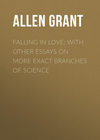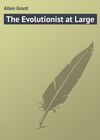Loe raamatut: «Falling in Love; With Other Essays on More Exact Branches of Science», lehekülg 9
There are several of these unconscious American importations in various parts of Britain, some of them, no doubt, brought over with seed-corn or among the straw of packing-cases, but others unconnected in any way with human agency, and owing their presence here to natural causes. That pretty little Yankee weed, the claytonia, now common in parts of Lancashire and Oxfordshire, first made its appearance amongst us, I believe, by its seeds being accidentally included with the sawdust in which Wenham Lake ice is packed for transport. The Canadian river-weed is known first to have escaped from the botanical gardens at Cambridge, whence it spread rapidly through the congenial dykes and sluices of the fen country, and so into the entire navigable network of the Midland counties. But there are other aliens of older settlement amongst us, aliens of American origin which nevertheless arrived in Britain, in all probability, long before Columbus ever set foot on the low basking sandbank of Cat Island. Such is the jointed pond-sedge of the Hebrides, a water-weed found abundantly in the lakes and tarns of the Isle of Skye, Mull and Coll, and the west coast of Ireland, but occurring nowhere else throughout the whole expanse of Europe or Asia. How did it get there? Clearly its seeds were either washed by the waves or carried by birds, and thus deposited on the nearest European shores to America. But if Mr. Alfred Russel Wallace had been alive in pre-Columban days (which, as Euclid remarks, is absurd), he would readily have inferred, from the frequent occurrence of such unknown plants along the western verge of Britain, that a great continent lay unexplored to the westward, and would promptly have proceeded to discover and annex it. As Mr. Wallace was not yet born, however, Columbus took a mean advantage over him, and discovered it first by mere right of primogeniture.
In other cases, the circumstances under which a particular plant appears in England are often very suspicious. Take the instance of the belladonna, or deadly nightshade, an extremely rare British species, found only in the immediate neighbourhood of old castles and monastic buildings. Belladonna, of course, is a deadly poison, and was much used in the half-magical, half-criminal sorceries of the Middle Ages. Did you wish to remove a troublesome rival or an elder brother, you treated him to a dose of deadly nightshade. Yet why should it, in company with many other poisonous exotics, be found so frequently around the ruins of monasteries? Did the holy fathers—but no, the thought is too irreverent. Let us keep our illusions, and forget the friar and the apothecary in 'Romeo and Juliet.'
Belladonna has never fairly taken root in English soil. It remains, like the Roman snail and the Portuguese slug, a mere casual straggler about its ancient haunts. But there are other plants which have fairly established their claim to be considered as native-born Britons, though they came to us at first as aliens and colonists from foreign parts. Such, to take a single case, is the history of the common alexanders, now a familiar weed around villages and farmyards, but only introduced into England as a pot-herb about the eighth or ninth century. It was long grown in cottage gardens for table purposes, but has for ages been superseded in that way by celery. Nevertheless, it continues to grow all about our lanes and hedges, side by side with another quaintly-named plant, bishop-weed or gout-weed, whose very titles in themselves bear curious witness to its original uses in this isle of Britain. I don't know why, but it is an historical fact that the early prelates of the English Church, saintly or otherwise, were peculiarly liable to that very episcopal disease, the gout. Whether their frequent fasting produced this effect; whether, as they themselves piously alleged, it was due to constant kneeling on the cold stones of churches; or whether, as their enemies rather insinuated, it was due in greater measure to the excellent wines presented to them by their Italian confrères, is a minute question to be decided by Mr. Freeman, not by the present humble inquirer. But the fact remains that bishops and gout got indelibly associated in the public mind; that the episcopal toes were looked upon as especially subject to that insidious disease up to the very end of the last century; and that they do say the bishops even now—but I refrain from the commission of scandalum magnatum. Anyhow, this particular weed was held to be a specific for the bishop's evil; and, being introduced and cultivated for the purpose, it came to be known indifferently to herbalists as bishop-weed and gout-weed. It has now long since ceased to be a recognised member of the British Pharmacopœia, but, having overrun our lanes and thickets in its flush period, it remains to this day a visible botanical and etymological memento of the past twinges of episcopal remorse.
Taken as a whole, one may fairly say that the total population of the British Isles consists mainly of three great elements. The first and oldest—the only one with any real claim to be considered as truly native—is the cold Northern, Alpine and Arctic element, comprising such animals as the white hare of Scotland, the ptarmigan, the pine marten, and the capercailzie—the last once extinct, and now reintroduced into the Highlands as a game bird. This very ancient fauna and flora, left behind soon after the Glacial Epoch, and perhaps in part a relic of the type which still struggled on in favoured spots during that terrible period of universal ice and snow, now survives for the most part only in the extreme north and on the highest and chilliest mountain-tops, where it has gradually been driven, like tourists in August, by the increasing warmth and sultriness of the southern lowlands. The summits of the principal Scotch hills are occupied by many Arctic plants, now slowly dying out, but lingering yet as last relics of that old native British flora. The Alpine milk vetch thus loiters among the rocks of Braemar and Clova; the Arctic brook-saxifrage flowers but sparingly near the summit of Ben Lawers, Ben Nevis, and Lochnagar; its still more northern ally, the drooping saxifrage, is now extinct in all Britain, save on a single snowy Scotch height, where it now rarely blossoms, and will soon become altogether obsolete. There are other northern plants of this first and oldest British type, like the Ural oxytrope, the cloudberry, and the white dryas, which remain as yet even in the moors of Yorkshire, or over considerable tracts in the Scotch Highlands; there are others restricted to a single spot among the Welsh hills, an isolated skerry among the outer Hebrides, or a solitary summit in the Lake District. But wherever they linger, these true-born Britons of the old rock are now but strangers and outcasts in the land; the intrusive foreigner has driven them to die on the cold mountain-tops, as the Celt drove the Mongolian to the hills, and the Saxon, in turn, has driven the Celt to the Highlands and the islands. Yet as late as the twelfth century itself, even the true reindeer, the Arctic monarch of the Glacial Epoch, was still hunted by Norwegian jarls of Orkney on the mainland of Caithness and Sutherlandshire.
Second in age is the warm western and south-western type, the type represented by the Portuguese slug, the arbutus trees and Mediterranean heaths of the Killarney district, the flora of Cornwall and the Scilly Isles, and the peculiar wild flowers of South Wales, Devonshire, and the west country generally. This class belongs by origin to the submerged land of Lyonesse, the warm champaign country that once spread westward over the Bay of Biscay, and derived from the Gulf Stream the genial climate still preserved by its last remnants at Tresco and St. Mary's. The animals belonging to this secondary stratum of our British population are few and rare, but of its plants there are not a few, some of them extending over the whole western shores of England, Wales, Scotland, and Ireland, wherever they are washed by the Gulf Stream, and others now confined to particular spots, often with the oddest apparent capriciousness. Thus, two or three southern types of clover are peculiar to the Lizard Point, in Cornwall; a little Spanish and Italian restharrow has got stranded in the Channel Islands and on the Mull of Galloway; the spotted rock-rose of the Mediterranean grows only in Kerry, Galway, and Anglesea; while other plants of the same warm habit are confined to such spots as Torquay, Babbicombe, Dawlish, Cork, Swansea, Axminster, and the Scilly Isles. Of course, all peninsulas and islands are warmer in temperature than inland places, and so these relics of the lost Lyonesse have survived here and there in Cornwall, Carnarvonshire, Kerry, and other very projecting headlands long after they have died out altogether from the main central mass of Britain. South-western Ireland in particular is almost Portuguese in the general aspect of its fauna and flora.
Third and latest of all in time, though almost contemporary with the southern type, is the central European or Germanic element in our population. Sad as it is to confess it, the truth must nevertheless be told, that our beasts and birds, our plants and flowers, are for the most part of purely Teutonic origin. Even as the rude and hard-headed Anglo-Saxon has driven the gentle, poetical, and imaginative Celt ever westward before him into the hills and the sea, so the rude and vigorous Germanic beasts and weeds have driven the gentler and softer southern types into Wales and Cornwall, Galloway and Connemara. It is to the central European population that we owe or owed the red deer, the wild boar, the bear, the wolf, the beaver, the fox, the badger, the otter, and the squirrel. It is to the central European flora that we owe the larger part of the most familiar plants in all eastern and southeastern England. They crossed in bands over the old land belt before Britain was finally insulated, and they have gone on steadily ever since, with true Teutonic persistence, overrunning the land and pushing slowly westward, like all other German bands before or since, to the detriment and discomfort of the previous inhabitants. Let us humbly remember that we are all of us at bottom foreigners alike, but that it is the Teutonic English, the people from the old Low Dutch fatherland by the Elbe, who have finally given to this isle its name of England, and to every one of us, Celt or Teuton, their own Teutonic name of Englishmen. We are at best, as an irate Teuton once remarked, 'nozzing but segond-hand Chermans.' In the words of a distinguished modern philologist of our own blood, 'English is Dutch, spoken with a Welsh accent.'
THUNDERBOLTS
The subject of thunderbolts is a very fascinating one, and all the more so because there are no such things in existence at all as thunderbolts of any sort. Like the snakes of Iceland, their whole history might, from the positive point of view at least, be summed up in the simple statement of their utter nonentity. But does that do away in the least, I should like to know, with their intrinsic interest and importance? Not a bit of it. It only adds to the mystery and charm of the whole subject. Does anyone feel as keenly interested in any real living cobra or anaconda as in the non-existent great sea-serpent? Are ghosts and vampires less attractive objects of popular study than cats and donkeys? Can the present King of Abyssinia, interviewed by our own correspondent, equal the romantic charm of Prester John, or the butcher in the next street rival the personality of Sir Roger Charles Doughty Tichborne, Baronet? No, the real fact is this: if there were thunderbolts, the question of their nature and action would be a wholly dull, scientific, and priggish one; it is their unreality alone that invests them with all the mysterious weirdness of pure fiction. Lightning, now, is a common thing that one reads about wearily in the books on electricity, a mere ordinary matter of positive and negative, density and potential, to be measured in ohms (whatever they may be), and partially imitated with Leyden jars and red sealing-wax apparatus. Why, did not Benjamin Franklin, a fat old gentleman in ill-fitting small clothes, bring it down from the clouds with a simple door-key, somewhere near Philadelphia? and does not Mr. Robert Scott (of the Meteorological Office) calmly predict its probable occurrence within the next twenty-four hours in his daily report, as published regularly in the morning papers? This is lightning, mere vulgar lightning, a simple result of electrical conditions in the upper atmosphere, inconveniently connected with algebraical formulas in x, y, z, with horrid symbols interspersed in Greek letters. But the real thunderbolts of Jove, the weapons that the angry Zeus, or Thor, or Indra hurls down upon the head of the trembling malefactor—how infinitely grander, more fearsome, and more mysterious!
And yet even nowadays, I believe, there are a large number of well-informed people, who have passed the sixth standard, taken prizes at the Oxford Local, and attended the dullest lectures of the Society for University Extension, but who nevertheless in some vague and dim corner of their consciousness retain somehow a lingering faith in the existence of thunderbolts. They have not yet grasped in its entirety the simple truth that lightning is the reality of which thunderbolts are the mythical, or fanciful, or verbal representation. We all of us know now that lightning is a mere flash of electric light and heat; that it has no solid existence or core of any sort; in short, that it is dynamical rather than material, a state or movement rather than a body or thing. To be sure, local newspapers still talk with much show of learning about 'the electric fluid' which did such remarkable damage last week upon the slated steeple of Peddlington Torpida Church; but the well-crammed schoolboy of the present day has long since learned that the electric fluid is an exploded fallacy, and that the lightning which pulled the ten slates off the steeple in question was nothing more in its real nature than a very big immaterial spark. However, the word thunderbolt has survived to us from the days when people still believed that the thing which did the damage during a thunderstorm was really and truly a gigantic white-hot bolt or arrow; and, as there is a natural tendency in human nature to fit an existence to every word, people even now continue to imagine that there must be actually something or other somewhere called a thunderbolt. They don't figure this thing to themselves as being identical with the lightning; on the contrary, they seem to regard it as something infinitely rarer, more terrible, and more mystic; but they firmly hold that thunderbolts do exist in real life, and even sometimes assert that they themselves have positively seen them.
But, if seeing is believing, it is equally true, as all who have looked into the phenomena of spiritualism and 'psychical research' (modern English for ghost-hunting) know too well, that believing is seeing also. The origin of the faith in thunderbolts must be looked for (like the origin of the faith in ghosts and 'psychical phenomena') far back in the history of our race. The noble savage, at that early period when wild in woods he ran, naturally noticed the existence of thunder and lightning, because thunder and lightning are things that forcibly obtrude themselves upon the attention of the observer, however little he may by nature be scientifically inclined. Indeed, the noble savage, sleeping naked on the bare ground, in tropical countries where thunder occurs almost every night on an average, was sure to be pretty often awaked from his peaceful slumbers by the torrents of rain that habitually accompany thunderstorms in the happy realms of everlasting dog-days. Primitive man was thereupon compelled to do a little philosophising on his own account as to the cause and origin of the rumbling and flashing which he saw so constantly around him. Naturally enough, he concluded that the sound must be the voice of somebody; and that the fiery shaft, whose effects he sometimes noted upon trees, animals, and his fellow-man, must be the somebody's arrow. It is immaterial from this point of view whether, as the scientific anthropologists hold, he was led to his conception of these supernatural personages from his prior belief in ghosts and spirits, or whether, as Professor Max Müller will have it, he felt a deep yearning in his primitive savage breast toward the Infinite and the Unknowable (which he would doubtless have spelt, like the Professor, with a capital initial, had he been acquainted with the intricacies of the yet uninvented alphabet); but this much at least is pretty certain, that he looked upon the thunder and the lightning as in some sense the voice and the arrows of an aërial god.
Now, this idea about the arrows is itself very significant of the mental attitude of primitive man, and of the way that mental attitude has coloured all subsequent thinking and superstition upon this very subject. Curiously enough, to the present day the conception of the thunderbolt is essentially one of a bolt—that is to say, an arrow, or at least an arrowhead. All existing thunderbolts (and there are plenty of them lying about casually in country houses and local museums) are more or less arrow-like in shape and appearance; some of them, indeed, as we shall see by-and-by, are the actual stone arrowheads of primitive man himself in person. Of course the noble savage was himself in the constant habit of shooting at animals and enemies with a bow and arrow. When, then, he tried to figure to himself the angry god, seated in the storm-clouds, who spoke with such a loud rumbling voice, and killed those who displeased him with his fiery darts, he naturally thought of him as using in his cloudy home the familiar bow and arrow of this nether planet. To us nowadays, if we were to begin forming the idea for ourselves all over again de novo, it would be far more natural to think of the thunder as the noise of a big gun, of the lightning as the flash of the powder, and of the supposed 'bolt' as a shell or bullet. There is really a ridiculous resemblance between a thunderstorm and a discharge of artillery. But the old conception derived from so many generations of primitive men has held its own against such mere modern devices as gunpowder and rifle balls; and none of the objects commonly shown as thunderbolts are ever round: they are distinguished, whatever their origin, by the common peculiarity that they more or less closely resemble a dart or arrowhead.
Let us begin, then, by clearly disembarrassing our minds of any lingering belief in the existence of thunderbolts. There are absolutely no such things known to science. The two real phenomena that underlie the fable are simply thunder and lightning. A thunderstorm is merely a series of electrical discharges between one cloud and another, or between clouds and the earth; and these discharges manifest themselves to our senses under two forms—to the eye as lightning, to the ear as thunder. All that passes in each case is a huge spark—a commotion, not a material object. It is in principle just like the spark from an electrical machine; but while the most powerful machine of human construction will only send a spark for three feet, the enormous electrical apparatus provided for us by nature will send one for four, five, or even ten miles. Though lightning when it touches the earth always seems to us to come from the clouds to the ground, it is by no means certain that the real course may not at least occasionally be in the opposite direction. All we know is that sometimes there is an instantaneous discharge between one cloud and another, and sometimes an instantaneous discharge between a cloud and the earth.
But this idea of a mere passage of highly concentrated energy from one point to another was far too abstract, of course, for primitive man, and is far too abstract even now for nine out of ten of our fellow-creatures. Those who don't still believe in the bodily thunderbolt, a fearsome aërial weapon which buries itself deep in the bosom of the earth, look upon lightning as at least an embodiment of the electric fluid, a long spout or line of molten fire, which is usually conceived of as striking the ground and then proceeding to hide itself under the roots of a tree or beneath the foundations of a tottering house. Primitive man naturally took to the grosser and more material conception. He figured to himself the thunderbolt as a barbed arrowhead; and the forked zigzag character of the visible flash, as it darts rapidly from point to point, seemed almost inevitably to suggest to him the barbs, as one sees them represented on all the Greek and Roman gems, in the red right hand of the angry Jupiter.
The thunderbolt being thus an accepted fact, it followed naturally that whenever any dart-like object of unknown origin was dug up out of the ground, it was at once set down as being a thunderbolt; and, on the other hand, the frequent occurrence of such dart-like objects, precisely where one might expect to find them in accordance with the theory, necessarily strengthened the belief itself. So commonly are thunderbolts picked up to the present day that to disbelieve in them seems to many country people a piece of ridiculous and stubborn scepticism. Why, they've ploughed up dozens of them themselves in their time, and just about the very place where the thunderbolt struck the old elm-tree two years ago, too.
The most favourite form of thunderbolt is the polished stone hatchet or 'celt' of the newer stone age men. I have never heard the very rude chipped and unpolished axes of the older drift men or cave men described as thunderbolts: they are too rough and shapeless ever to attract attention from any except professed archæologists. Indeed, the wicked have been known to scoff at them freely as mere accidental lumps of broken flint, and to deride the notion of their being due in any way to deliberate human handicraft. These are the sort of people who would regard a grand piano as a fortuitous concourse of atoms. But the shapely stone hatchet of the later neolithic farmer and herdsman is usually a beautifully polished wedge-shaped piece of solid greenstone; and its edge has been ground to such a delicate smoothness that it seems rather like a bit of nature's exquisite workmanship than a simple relic of prehistoric man. There is something very fascinating about the naïf belief that the neolithic axe is a genuine unadulterated thunderbolt. You dig it up in the ground exactly where you would expect a thunderbolt (if there were such things) to be. It is heavy, smooth, well shaped, and neatly pointed at one end. If it could really descend in a red-hot state from the depths of the sky, launched forth like a cannon-ball by some fierce discharge of heavenly artillery, it would certainly prove a very formidable weapon indeed; and one could easily imagine it scoring the bark of some aged oak, or tearing off the tiles from a projecting turret, exactly as the lightning is so well known to do in this prosaic workaday world of ours. In short, there is really nothing on earth against the theory of the stone axe being a true thunderbolt, except the fact that it unfortunately happens to be a neolithic hatchet.
But the course of reasoning by which we discover the true nature of the stone axe is not one that would in any case appeal strongly to the fancy or the intelligence of the British farmer. It is no use telling him that whenever one opens a barrow of the stone age one is pretty sure to find a neolithic axe and a few broken pieces of pottery beside the mouldering skeleton of the old nameless chief who lies there buried. The British farmer will doubtless stolidly retort that thunderbolts often strike the tops of hills, which are just the places where barrows and tumuli (tumps, he calls them) most do congregate; and that as to the skeleton, isn't it just as likely that the man was killed by the thunderbolt as that the thunderbolt was made by a man? Ay, and a sight likelier, too.
All the world over, this simple and easy belief, that the buried stone axe is a thunderbolt, exists among Europeans and savages alike. In the West of England, the labourers will tell you that the thunder-axes they dig up fell from the sky. In Brittany, says Mr. Tylor, the old man who mends umbrellas at Carnac, beside the mysterious stone avenues of that great French Stonehenge, inquires on his rounds for pierres de tonnerre, which of course are found with suspicious frequency in the immediate neighbourhood of prehistoric remains. In the Chinese Encyclopædia we are told that the 'lightning stones' have sometimes the shape of a hatchet, sometimes that of a knife, and sometimes that of a mallet. And then, by a curious misapprehension, the sapient author of that work goes on to observe that these lightning stones are used by the wandering Mongols instead of copper and steel. It never seems to have struck his celestial intelligence that the Mongols made the lightning stones instead of digging them up out of the earth. So deeply had the idea of the thunderbolt buried itself in the recesses of his soul, that though a neighbouring people were still actually manufacturing stone axes almost under his very eyes, he reversed mentally the entire process, and supposed they dug up the thunderbolts which he saw them using, and employed them as common hatchets. This is one of the finest instances on record of the popular figure which grammarians call the hysteron proteron, and ordinary folk describe as putting the cart before the horse. Just so, while in some parts of Brazil the Indians are still laboriously polishing their stone hatchets, in other parts the planters are digging up the precisely similar stone hatchets of earlier generations, and religiously preserving them in their houses as undoubted thunderbolts. I have myself had pressed upon my attention as genuine lightning stones, in the West Indies, the exquisitely polished greenstone tomahawks of the old Carib marauders. But then, in this matter, I am pretty much in the position of that philosophic sceptic who, when he was asked by a lady whether he believed in ghosts, answered wisely, 'No, madam, I have seen by far too many of them.'
One of the finest accounts ever given of the nature of thunderbolts is that mentioned by Adrianus Tollius in his edition of 'Boethius on Gems.' He gives illustrations of some neolithic axes and hammers, and then proceeds to state that in the opinion of philosophers they are generated in the sky by a fulgureous exhalation (whatever that may look like) conglobed in a cloud by a circumfixed humour, and baked hard, as it were, by intense heat. The weapon, it seems, then becomes pointed by the damp mixed with it flying from the dry part, and leaving the other end denser; while the exhalations press it so hard that it breaks out through the cloud, and makes thunder and lightning. A very lucid explanation certainly, but rendered a little difficult of apprehension by the effort necessary for realising in a mental picture the conglobation of a fulgureous exhalation by a circumfixed humour.
One would like to see a drawing of the process, though the sketch would probably much resemble the picture of a muchness, so admirably described by the mock turtle. The excellent Tollius himself, however, while demurring on the whole to this hypothesis of the philosophers, bases his objection mainly on the ground that, if this were so, then it is odd the thunderbolts are not round, but wedge-shaped, and that they have holes in them, and those holes not equal throughout, but widest at the ends. As a matter of fact, Tollius has here hit the right nail on the head quite accidentally; for the holes are really there, of course, to receive the haft of the axe or hammer. But if they were truly thunderbolts, and if the bolts were shafted, then the holes would have been lengthwise, as in an arrowhead, not crosswise, as in an axe or hammer. Which is a complete reductio ad absurdum of the philosophic opinion.
Some of the cerauniæ, says Pliny, are like hatchets. He would have been nearer the mark if he had said 'are hatchets' outright. But this aperçu, which was to Pliny merely a stray suggestion, became to the northern peoples a firm article of belief, and caused them to represent to themselves their god Thor or Thunor as armed, not with a bolt, but with an axe or hammer. Etymologically Thor, Thunor, and thunder are the self-same word; but while the southern races looked upon Zeus or Indra as wielding his forked darts in his red right hand, the northern races looked upon the Thunder-god as hurling down an angry hammer from his seat in the clouds. There can be but little doubt that the very notion of Thor's hammer itself was derived from the shape of the supposed thunderbolt, which the Scandinavians and Teutons rightly saw at once to be an axe or mallet, not an arrow-head. The 'fiery axe' of Thunor is a common metaphor in Anglo-Saxon poetry. Thus, Thor's hammer is itself merely the picture which our northern ancestors formed to themselves, by compounding the idea of thunder and lightning with the idea of the polished stone hatchets they dug up among the fields and meadows.
Flint arrowheads of the stone age are less often taken for thunderbolts, no doubt because they are so much smaller that they look quite too insignificant for the weapons of an angry god. They are more frequently described as fairy-darts or fairy-bolts. Still, I have known even arrow-heads regarded as thunderbolts, and preserved superstitiously under that belief. In Finland, stone arrows are universally so viewed; and the rainbow is looked upon as the bow of Tiermes, the thunder-god, who shoots with it the guilty sorcerers.




















